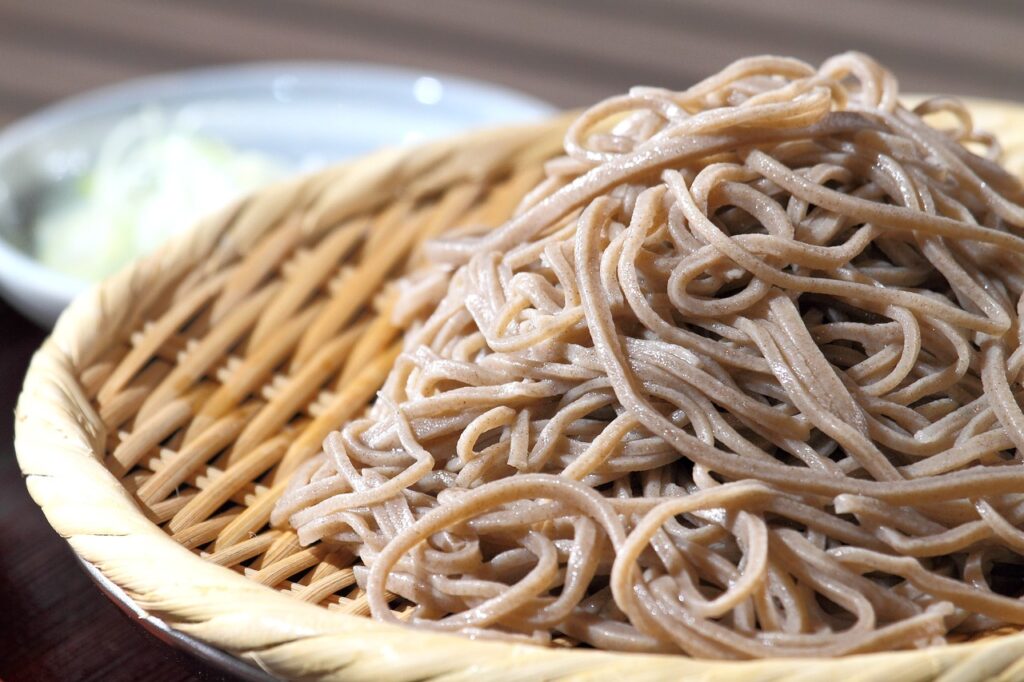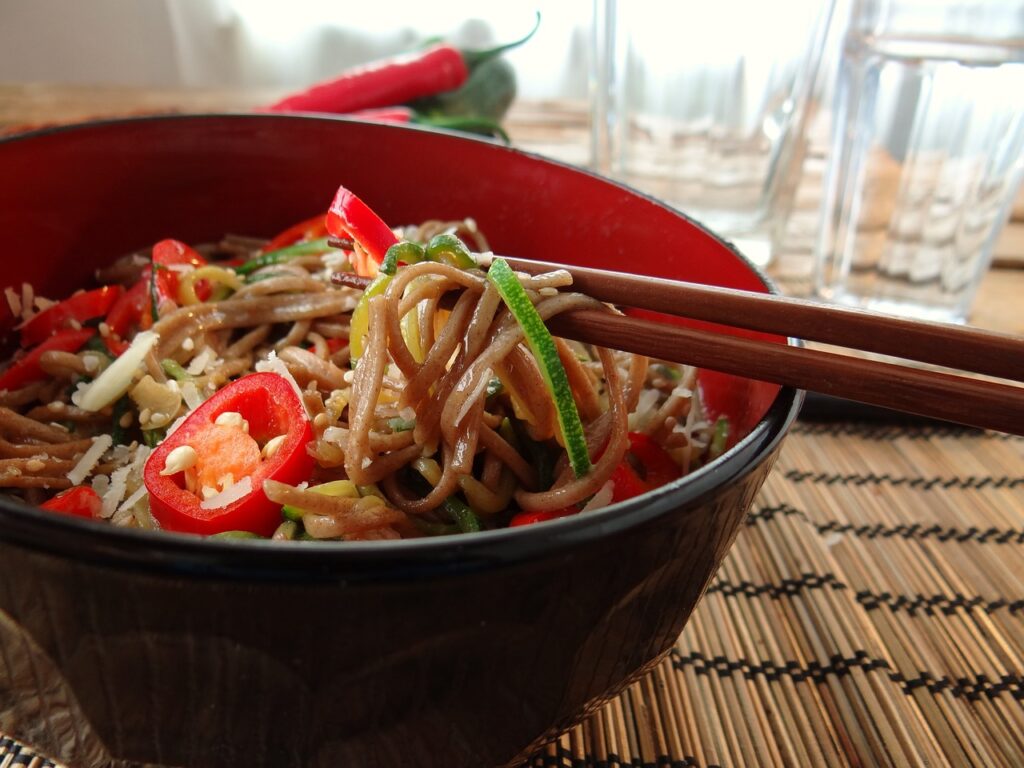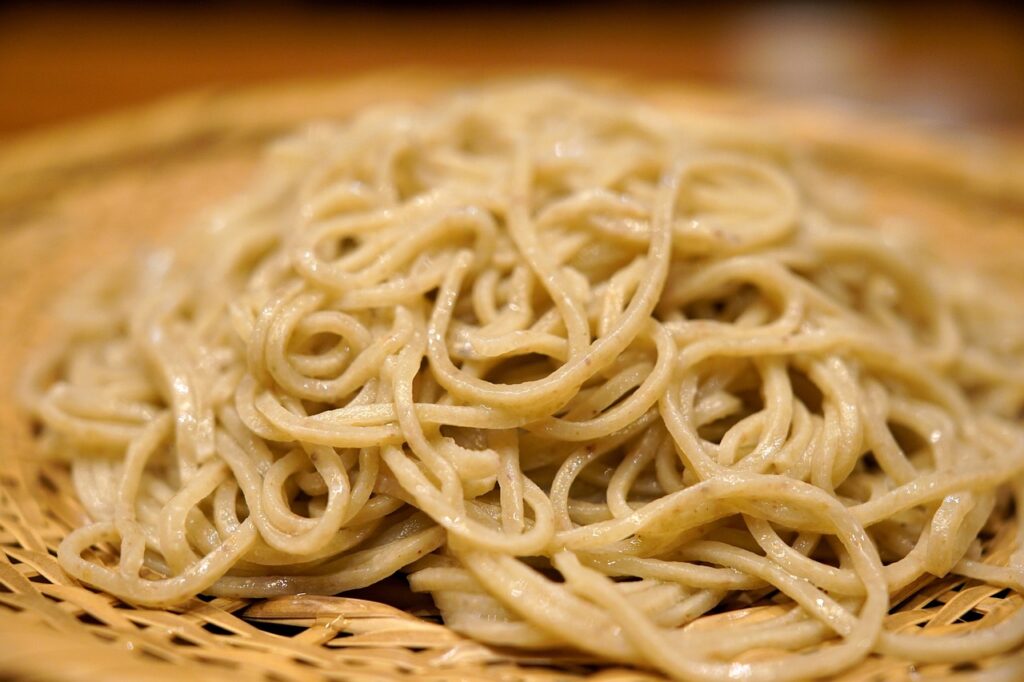Are Soba Noodles Low FODMAP? Read Before You Eat!
Soba noodles have become increasingly popular in recent years as people look for healthier alternatives to traditional pasta. Made from buckwheat flour, these Japanese noodles offer a unique taste and texture that many find appealing.
As someone following the low FODMAP diet, you might be wondering, -are soba noodles low FODMAP?
Good news! Soba noodles made purely from buckwheat flour are low in FODMAPs, making them a suitable option for those following this dietary approach. In this guide, we tell you all about some precautions to follow when adding buckwheat soba noodles to your meals.
Are Soba Noodles Low FODMAP?

Yes, soba noodles made from buckwheat flour are low in FODMAPs. However, it’s essential to read the ingredient list, as some brands may contain additional high-FODMAP ingredients, such as wheat.
By choosing the right soba noodles and pairing them with low-FODMAP ingredients, you can create delicious and gut-friendly meals to enjoy without worry.
To ensure that the soba noodles you consume are low in FODMAPs, you should carefully check the ingredient list on the package. Look for ones that use 100% buckwheat flour. If you’re unable to find noodles made entirely from buckwheat flour, consider making your own using a gluten-free flour blend.
Nutrition in Soba Noodles
Here is a sample nutrition table for a standard serving of soba noodles:
| Nutrient | Amount per serving |
|---|---|
| Calories | 200 |
| Carbohydrates | 36g |
| Protein | 7g |
| Fat | 2g |
| Fiber | 3g |
Sugar Content in Soba Noodles
| Component | Amount per serving |
|---|---|
| Glucose | 5g |
| Fructose | 4g |
| Excess Fructose | 0g |
Low-FODMAP Serving Sizes for Soba Noodles

Soba noodles, made from buckwheat, can be a suitable option for those following a low-FODMAP diet. However, it is important to pay attention to serving sizes, as larger portions may increase the FODMAP content of your meal.
In general, a single serving of pure soba noodles (made from 100% buckwheat) is approximately 90 grams cooked, which should maintain its low FODMAP status. To ensure you’re consuming an ideal portion size, consider using a food scale or measuring cups to measure out your noodles.
Portion Control Tips
Here are some tips to help with portion control and stick to low-FODMAP serving sizes for soba noodles:
Use measuring tools
Utilize a food scale or measuring cup to help portion your noodles accurately. This will keep you mindful of the amount you’re eating and help you avoid exceeding the suggested serving size.
Combine with low-FODMAP ingredients
Partner your soba noodles with other low-FODMAP foods, such as veggies or protein sources, to create a well-balanced meal. This will help ensure that overall FODMAP levels remain low.
Pay attention to your body
Remember to listen to your body and its signals. If you find that a certain serving size of soba noodles doesn’t work for you, adjust it accordingly. This might mean reducing the portion or finding an alternative low-FODMAP pasta option.
Alternative Low-FODMAP Noodles

On your journey to finding low-FODMAP noodles, you’re in luck, as there are several alternative options for you to try. Here we will explore three alternative low-FODMAP noodles: Rice Noodles, Corn Pasta, and Quinoa Pasta.
Rice Noodles
You can find rice noodles in various shapes and sizes, such as vermicelli, flat noodles, or even thicker udon-style noodles. They’re perfect for stir-fries, noodle soups, or just served with your favorite low-FODMAP sauce.
To prepare rice noodles:
- Bring a pot of water to a boil.
- Add rice noodles and cook for 3-5 minutes, or until they’re tender.
- Drain and rinse under cold water to stop the cooking process.
- Serve with your choice of low-FODMAP ingredients and enjoy!
Corn Pasta
Made from corn flour, corn pasta gluten-free and easy on your digestive system, making it a suitable choice for those with IBS or other digestive disorders. Corn pasta is available in various shapes and sizes, such as spaghetti, fusilli, or penne, making it an easy switch for your favorite pasta dishes.
To cook corn pasta:
- Bring a large pot of water to a boil.
- Add corn pasta and stir occasionally to prevent sticking.
- Cook according to package instructions, usually between 7-10 minutes.
- Drain and toss with your favorite low-FODMAP sauce or ingredients for a tasty meal.
Quinoa Pasta
Made from quinoa flour, this is gluten-free and packed with nutrients like protein, fiber, and iron. Quinoa pasta is a versatile choice, as you can find it in various shapes, making it a delicious and nutritious substitute for your regular pasta dishes.
To prepare quinoa pasta:
- Bring a pot of water to a boil.
- Add quinoa pasta and stir occasionally to prevent clumping.
- Cook according to package instructions, typically around 8–10 minutes.
- Drain and serve with your choice of low-FODMAP ingredients for a satisfying meal.
Also Read: Is Coke Low FODMAP?
Preparing Low-FODMAP Soba Noodles Dishes

To create delicious low-FODMAP soba noodles dishes, follow these simple tips:
Check Ingredients
First, check the ingredients list to ensure your soba noodles are 100% buckwheat. Some brands may blend buckwheat flour with wheat flour, which increases the FODMAP content. Opt for noodles that are made purely from buckwheat to keep them low-FODMAP.
Avoid Over-cooking
When cooking your soba noodles, ensure that you don’t overcook them. They should be cooked al dente, which means they’re still firm when bitten. To achieve this, bring a pot of water to a boil, add the noodles, and cook for approximately 4-6 minutes. Then, drain and rinse the noodles under cold water to prevent them from sticking together.
Pair Them With Low-FODMAP Ingredients
As you create your dish, pair your soba noodles with low-FODMAP ingredients. Some tasty options include grilled chicken, poached shrimp, or tofu for protein. For vegetables, consider incorporating spinach, kale, bell peppers, or zucchini. Remember to monitor portion sizes, as some low-FODMAP foods can become high-FODMAP when consumed in large quantities.
Use Low-FODMAP Seasonings
When it comes to seasoning your dish, try using homemade sauces or dressings made from low-FODMAP ingredients. Soy sauce is typically high in FODMAPs, but you can use tamari sauce as a gluten-free and low-FODMAP alternative. For a flavorful dressing, mix together tamari sauce, rice vinegar, sesame oil, and a hint of ginger.
Frequently Asked Questions
What are some low FODMAP noodle alternatives?
Rice noodles, such as those used in dishes like pad Thai, are an excellent choice since they are made from rice flour and are naturally low in FODMAPs.
Another option is to choose gluten-free pasta made from ingredients like corn or quinoa, which are also low in FODMAPs. You might also consider trying buckwheat noodles, as they can be low in FODMAPs when eaten in moderation.
What are the best low-FODMAP ramen brands?
Finding a low FODMAP ramen brand might seem challenging, but there are options available with a bit of research.
Look for gluten-free and rice-based ramen noodles, which are generally lower in FODMAPs than traditional wheat-based ramen noodles. When it comes to the soup base or flavorings, avoid high-FODMAP ingredients like onion, garlic, and certain spices.
Some brands like FODY Foods and Casa de Sante offer low FODMAP ramen options specifically designed for those following a low FODMAP diet. Additionally, you can make your own low FODMAP ramen at home using suitable noodles and a homemade broth made with low FODMAP ingredients.
Conclusion – Are Soba Noodles Low FODMAP?
Yes, soba noodles can be low in FODMAPs provided you select the right variety and pay attention to the ingredients used in the dish. It’s important to remember that everyone’s tolerance to FODMAPs can vary, so it’s essential to listen to your body and adjust your diet accordingly.

Jane Porter is an architect that like many others, had her life significantly impacted by digestive problems for many year. Trying to find a solution to her digestive problem, she came across the low FODMAP diet, a scientifically-backed approach designed to alleviate symptoms associated with irritable bowel syndrome (IBS) and other digestive disorders.

